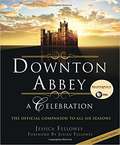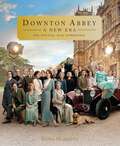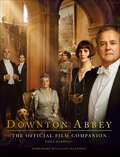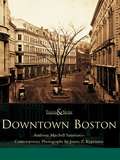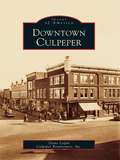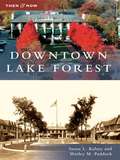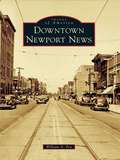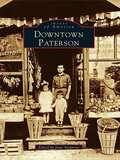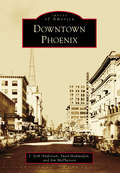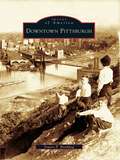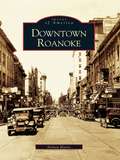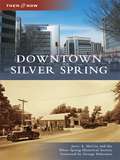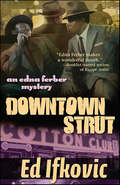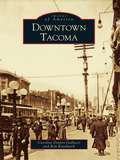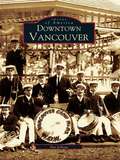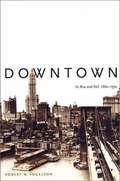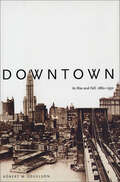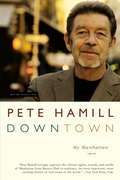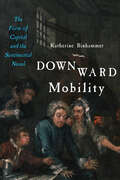- Table View
- List View
Downshore From Manahawkin to New Gretna (Images of America)
by The Publications Committee of the Ocean County Historical SocietyA unique area exists along the western shores of Little Egg Harbor Bay and Great Bay between the communities of Manahawkin and New Gretna in the southern coastal section of New Jersey. From the beginning, the region was rich in natural resources, providing fish, clams, oysters, lumber, and cranberries for early settlers. The communities also enjoyed a temperate climate and navigable harbors, leading to the development of shipbuilding and trading as early industries. Because of the isolation of the Tuckerton area from the larger population centers of the state, its small-town flavor and way of life were allowed to endure. Many of the occupations of the settlers of the early 1700s survive to this day. Downshore from Manahawkin to New Gretna seeks to capture the charm of the little towns in this region, the character of the people who settled here, many of whose families still remain, and the lifestyle lived in harmony with this pastoral environment during the nineteenth and early twentieth centuries.
Downton Abbey - A Celebration: The Official Companion to All Six Series
by Jessica FellowesSince the moment we first entered Downton Abbey in 1912, we have been swept away by Julian Fellowes' evocative world of romance, intrigue, drama and tradition. Now, in 1925, as Downton Abbey prepares to close its doors for the final time, Jessica Fellowes leads us through the house and estate, reliving the iconic moments of the wonderfully aristocratic Crawley family and their servants as they navigate the emerging modern age. Travelling from Great Hall to servants' hall, bedroom to boot room, we glimpse as we go Matthew and Isobel Crawley arriving for the first time, the death of Kemal Pamuk, Cora's tragic miscarriage, Edith's affair with Michael Gregson, Mary's new haircut, Thomas and O'Brien's scheming, Anna and Bates's troubles with the law, and Carson's marriage to Mrs Hughes.Alongside this will be in-depth interviews with the cast who have worked on the show for six years and know it so well. Packed full of stunning location shots and stills from all six series of the show including exclusive behind-the-scenes photography, this celebratory book is the ultimate gift for Downton Abbey fans the world over.
Downton Abbey - A Celebration: The Official Companion to All Six Series
by Jessica FellowesSince the moment we first entered Downton Abbey in 1912, we have been swept away by Julian Fellowes' evocative world of romance, intrigue, drama and tradition. Now, in 1925, as Downton Abbey prepares to close its doors for the final time, Jessica Fellowes leads us through the house and estate, reliving the iconic moments of the wonderfully aristocratic Crawley family and their servants as they navigate the emerging modern age. Travelling from Great Hall to servants' hall, bedroom to boot room, we glimpse as we go Matthew and Isobel Crawley arriving for the first time, the death of Kemal Pamuk, Cora's tragic miscarriage, Edith's affair with Michael Gregson, Mary's new haircut, Thomas and O'Brien's scheming, Anna and Bates's troubles with the law, and Carson's marriage to Mrs Hughes.Alongside this will be in-depth interviews with the cast who have worked on the show for six years and know it so well. Packed full of stunning location shots and stills from all six series of the show including exclusive behind-the-scenes photography, this celebratory book is the ultimate gift for Downton Abbey fans the world over.
Downton Abbey: The Official Film Companion
by Emma MarriottThe worldwide phenomenon and multi-award winning Downton Abbey returns to the big screen with a movie sequel starring the Crawley family and their household staff—and the Downton Abbey: A New Era: The Official Film Companion is the Downton fan&’s front-row ticket to all the behind-the-scenes action. In addition to the original principal cast—including Dame Maggie Smith as the Dowager Countess, Michelle Dockery as Lady Mary, and Hugh Bonneville and Elizabeth McGovern as Lord and Lady Grantham—fans will gain an unprecedented look at the new Downton characters, including those played by new cast members Hugh Dancy, Laura Haddock, Nathalie Baye, and Dominic West. Featuring spectacular photographs from the production, interviews with the cast and crew, and insight from Downton Abbey writer and creator Julian Fellowes, Downton Abbey: A New Era: The Official Film Companion gives fans an in-depth experience of the magic and elegance of Downton Abbey.
Downton Abbey: The Official Film Companion
by Emma MarriottThe official companion to Downton Abbey, the full-length feature film, featuring cast and crew interviews, photos, costume illustrations & more.Downton Abbey: The Official Film Companion is a stunning memento, bringing the world and the characters of our favorite fictional country house to life. Featuring spectacular photographs from the production, interviews with the cast and crew, and a look into the historical and geographical backdrop of the film, this official guide to the Downton Abbey film is made to be treasured and loved by fans across the globe.The film revolves around the King and Queen making an official visit to Downton in 1927, and not only sees the return of all the main cast from the final television series, but also introduces some great British actors to the world of Downton, as we meet the royal family and their retinue. The accompanying book is lavishly illustrated with stunning shots from both behind and in front of the camera, which capture some wonderful off-guard moments during filming, as well as the original costume illustrations.With a foreword from Downton Abbey creator Julian Fellowes.
Downtown Ann Arbor
by Patti Smith Mayor John HieftjeIn 1824, John Allen and Elisha Rumsey established the first homestead in what is now downtown Ann Arbor. The story goes that the community got its name when the two founders' wives, both named Ann, were seen lounging in a grove of trees. In reality, Ann Allen and Mary Ann Rumsey were never in town at the same time, but how it actually was named is unimportant when considering what Ann Arbor grew into. Early settlers gave the town schools, an expansive courthouse, a beautiful post office, and streetcar lines that spanned downtown. They built this town, and their legacy is present in every walk up Huron Street, drive down to William and Main Streets, or bike ride over to Kerrytown.
Downtown Boston
by Anthony Mitchell Sammarco James Z. KyprianosSettled in 1630 by English Puritans seeking religious freedom, Boston has always been a city prone to significant and monumental change. Even before it was incorporated as Boston, named after the town of Boston in Lincolnshire, England, the town's name was changed from Shawmut. From that time, Boston has evolved from being the original center of town government at the Old State House to becoming the financial center of New England in the twentieth century.Downtown Boston captures many of Boston's intriguing changes with photographs of the past and present. Since the advent of photography one hundred and fifty years ago, Boston has seen many topographical changes, such as the infilling that created new land in the Dock Square and Long Wharf areas and the rebuilding of the Financial District with magnificent structures that have become a representation of Boston's banking and investment endeavors. At the height of commercial success, the Great Boston Fire of 1872 brought mass devastation-forty acres of the business area were destroyed and downtown Boston had to be rebuilt. Downtown Boston magnificently portrays Boston's rebuilding and rise as a historically beautiful city.
Downtown Culpeper
by Inc. Culpeper Renaissance Diane LoganIn 1749, George Washington, age 17, was commissioned to survey and plot the town and county of Culpeper. He recorded that the town occupied a "high and pleasant situation." Incorporated in 1834, Culpeper prospered as a major trading and shipping point with the opening of a stagecoach route. The arrival of the railroad in 1853 spurred even more economic development and made Culpeper a strategic supply station for Confederate and Union troops. Occupied by both armies throughout the war, the Culpeper area witnessed more than 100 battles and skirmishes and received many Confederate and Union generals. Military headquarters were established here, with officers lodged in hotels and dining and entertaining downtown. Much of downtown Culpeper was built following the Civil War. The architectural character today reflects the 1888 building boom of High Victorian and Italianate styles.
Downtown Everett
by M. L. DehmSituated on a deep-water bay, Everett's timber-covered peninsula was irresistible to early investors. Natural resources were abundant, and it was whispered that the Great Northern Railroad would soon make this hidden treasure its final destination. Hopes were high and money began to exchange hands. But the Panic of 1893 was right around the corner. Everett never would achieve the "big city" grandeur that Eastern speculators had originally predicted. Nevertheless, the sturdy city by Port Gardner Bay withstood financial panic, depressions, and riots to become the proud seat of Snohomish County. Once heralded as the "Pittsburgh of the West" and the "City of Smokestacks," Everett remains a dynamic city of industry.
Downtown Lake Forest (Then and Now)
by Shirley M. Paddock Susan L. KelseyLake Forest is a picturesque city built on the shores of Lake Michigan and has been home to Chicago's capitalist families, who developed estates around beautiful Lake Forest College. For over 150 years, the Lake Forest Central Business District has been the heart of the community.
Downtown Minneapolis (Images of America)
by Iric NathansonDowntown Minneapolis evolved from a collection of modest frame buildings on the banks of the Mississippi River to the high-rise center of a modern American metropolis. With a burgeoning milling industry powering the local economy, the early frame structures soon gave way to substantial brick and masonry buildings, lining the streets of a bustling 19th-century commercial district. Downtown continued to prosper during the early years of the 20th century, aided by advances in transportation and communications. The heart of the city held its own during the Great Depression and World War II, but the postwar era brought new challenges as a suburban boom threatened the city's economic foundation. Enterprising local leaders responded with innovative developments to meet these challenges, and a reinvigorated downtown took on a new role as the site of a dynamic new residential community, now home to nearly 40,000 city residents.
Downtown Newport News (Images of America)
by William A. FoxSettled in 1621, Newport News has the oldest English place name of any city in the New World. Its name is said to have come from "Newport's news" that supply ships were coming to save the starving Jamestown colonists in 1610. Farming and fishing were the primary occupations until Collis P. Huntington chose Newport News for the eastern terminus of the Chesapeake and Ohio Railway in the 1870s. In 1886, he founded the Newport News Shipbuilding and Dry Dock Company, which has built some of the most famous ships in history. By 1900, a vital city had grown where there were previously only farms and forest. Through vivid images, maps, and reminiscences, Images of America: Downtown Newport News tells the story of the city's once popular and thriving downtown commercial, social, and entertainment area, which met its end from flight to the suburbs after World War II.
Downtown Paterson
by June AvignoneIt was a corporate experiment--an experiment that would later be known as Paterson, New Jersey. Home of the Great Falls, Paterson holds the distinction of being the first planned industrial center of the United States. The land of the Lenape and a few Dutch settlers would be forever changed when politicians and wealthy investors founded Paterson as a corporation, as opposed to chartering it as a city, in 1792. At a crucial turning point in our young, agrarian-based nation, the struggles and triumphs of individuals from diverse ethnic groups would be set into historic motion. Over 100 photographs of Paterson's rich past and complicated present have been woven together with text from noted historians and poets, focusing on the downtown historic area. Downtown Paterson takes us on a journey from the beginnings of the proverbial SilkCity through its radical labor past and days of pre-mall grandeur with a thriving Main Street abundant with elegant stores, vaudeville houses, and movie theaters. This volume ends with a probing look at the city's present-day people and places.
Downtown Phoenix
by Jim Mcpherson J. Seth Anderson Suad MahmuljinOn a bed of a primordial ocean floor and in a valley surrounded by jagged mountains, a city was founded atop the ruins of a vanished civilization. In 1867, former Confederate soldier Jack Swilling saw the remains of an ancient canal system and the potential for the area to blossom into a thriving agricultural center. Pioneers moved into the settlement searching for new opportunities, and on October 20, 1870, residents living in adobe structures that lined dirt streets adopted the name Phoenix, expressing the optimism of the frontier. For decades, downtown Phoenix was a dense urban core, the hub of agricultural fields, mining settlements, and military posts. Unfortunately, suburban sprawl and other social factors of the post-World War II era led to the center's decline. With time, things changed, and now downtown Phoenix is uniquely positioned to rise again as a prominent 21st-century American city.
Downtown Pittsburgh
by Stuart P. BoehmigDowntown Pittsburgh is a 300-acre triangle of land where the Allegheny and Monongahela Rivers converge to form the mighty Ohio River. Between the rivers is a tiny spit of flat-bottom land once known as the gateway to the West, the portal to a vast, remote, unexplored wilderness. Ownership of this strategic wedge of land was fiercely contested for hundredsof years. The powerful Iroquois Nation first invaded the area in the 1600s during the Beaver Wars. When the French planted their flag in 1749, they collided with the British Empire for control of the forks of the Ohio River and all of North America. One hundred years later, this swath of frontier wilderness became the "workplace of the world," the heart of the great Industrial Revolution. Immigrants arrived from around Europe to work in the glass, iron, and steel mills. Industrial giants such as Carnegie, Frick, Mellon, and Heinz forged their fortunes here.Downtown Pittsburgh is the story of the great transformation of this city and its contributions to the world.
Downtown Roanoke
by Nelson HarrisDowntown Roanoke celebrates the vibrant history of a community that lies at the heart of the scenic Roanoke Valley. From the saloons and livery stables of the late 19th century to the flagship department stores that attracted hundreds of shoppers in the late 1950s, Roanoke has experienced dramatic change. Over 200 archival images have been compiled to produce a stunning collage of the downtown area over the past century. Included are the American Theater, the Rialto, the Jefferson, and the time-altered streetscapes of Jefferson, Campbell, Kirk, and Church. This collection highlights the storied past of Roanoke through hotels, hospitals, churches, merchants, and special events, including the American Legion parades, the Diamond Jubilee, and the march of the VMI and VPI cadets at Thanksgiving en route to Victory Stadium. Downtown Roanoke is a tribute to the heritage of Southwestern Virginia's leading urban center. Today it remains a metropolitan district alive with culture and commerce, having re-emerged from the challenges of shopping malls and suburbia. The photographs in this collection, many published for the first time, provide a nostalgic look at the progress of Roanoke's historic downtown corridor.
Downtown Silver Spring (Then and Now)
by George Pelecanos Jerry A. Mccoy Silver Spring Historical SocietyIn 1840, journalist and politician Francis Preston Blair discovered a sparkling mica-flecked spring that would serve as the centerpiece of his country estate, Silver Spring. In just over a century, this bucolic woodland, located across the border from Washington, D.C., became known as downtown Silver Spring, Maryland. Author Jerry A. McCoy, founder and president of the Silver Spring Historical Society and a special collections librarian at the D.C. Public Library's Washingtoniana Division and Peabody Room, offers readers a tour of this dynamic central business district and surrounds.
Downtown St. Paul (Images of America)
by Iric NathansonMinnesota's capital city was given a lofty identity when young Catholic priest Lucien Gaultier built a modest log chapel in a wilderness clearing and named it for his patron saint. St. Paul's modern downtown would later take shape at this very site. In the mid-19th century, St. Paul's strategic location at the head of navigation on the Mississippi River was naturally suited as a way station for goods and a hub for settlers pouring into the Upper Midwest. While St. Paul had to relinquish its ranking as Minnesota's largest city to its twin, Minneapolis, the city remains at the center of state politics as Minnesota's state capital. Following World War II, a suburban boom weakened the business district, and downtown St. Paul fell into decline. Over the last 40 years, however, St. Paul's downtown has been reinvented as a major sports, entertainment, and cultural center.
Downtown Strut: An Edna Ferber Mystery (Edna Ferber Mysteries #4)
by Ed Ifkovic"Fans of mysteries featuring literary figures as crime-solvers will thoroughly enjoy this series." —BooklistIt's 1927, and "the Ferber season on Broadway" is about to begin. The musical adaptation of Show Boat by Oscar Hammerstein and Jerome Kern opens on December 27, and The Royal Family, her comedy of manners written with George Kaufman, opens the following night. But despite the excitement, author Edna Ferber misses both opening nights. She has something else on her mind—murder.Edna is fascinated by the Roaring Twenties' Harlem Renaissance. In fact, she has been mentoring some of these talented, young "Negro" writers and actors, among them her housekeeper's son, Waters Turpin, and the handsome, charismatic Roddy Parsons. She heads to Harlem to take Parsons to lunch, only to discover he's been stabbed to death in his bed.Who would murder Roddy? Suspects include the writers who meet at Edna's apartment and the young producer Jed Harris, a darling of the Broadway set who is a notoriously cruel man. With the help of Waters Turpin, his mother, and poet Langston Hughes, Edna sets off to track down a dangerous killer.
Downtown Tacoma
by Ron Karabaich Caroline Denyer GallacciIn 1873, the Northern Pacific Railroad selected the south shore of Commencement Bay as the terminus of its transcontinental line. Connected to, but independent of the railroad, the Tacoma Land Company created a city adjacent to the terminus. By the early years of the 20th century, downtown Tacoma was the place to go for a wide array of activities from retail shopping and government activity to entertainment. Streetcars, and then automobiles, contributed to the ever-changing vitality of people and place. After the late 1960s, when developers constructed a mall south of the central core, city planners created a new type of urban experience centered on amenities designed to lure tourists and Tacomans alike.
Downtown Vancouver
by Pat JollotaNamed for a British sea explorer, Vancouver was conceived in the early 1800s when Lewis and Clark camped at the waterfront and deemed the area ripe for settlement. The Hudson's Bay Company soon established its fur-trading empire here, and "Fort Vancouver" became the commercial center of the area. In 1849 American troops set up Columbia Barracks nearby, establishing the area as a military stronghold. In 1857 the city of Vancouver was incorporated, and gradually became an important industrial and residential city. Vancouver is now a big city, and along with nearby Portland, Oregon, is home to high-tech, maritime, lumber, and manufacturing industries.
Downtown: Its Rise and Fall, 1880-1950
by Robert M. FogelsonDowntown is the first history of what was once viewed as the heart of the American city. Urban historian Robert Fogelson gives a riveting account of how downtown--and the way Americans thought about it--changed between 1880 and 1950. Recreating battles over subways and skyscrapers, the introduction of elevated highways and parking bans, and other controversies, this book provides a new and often starling perspective on downtown's rise and fall.
Downtown: Its Rise and Fall, 1880–1950
by Robert M. FogelsonWinner of a Lewis Mumford Prize: “Extremely engaging reading for those interested in the history of cities and urban experience.” —Booklist Written by one of this country’s foremost urban historians, Downtown is the first history of what was once viewed as the heart of the American city. It tells the fascinating story of how downtown—and the way Americans thought about downtown—changed over time. By showing how businessmen and property owners worked to promote the well-being of downtown, even at the expense of other parts of the city, it also gives a riveting account of spatial politics in urban America.Drawing on a wide array of contemporary sources, Robert M. Fogelson brings downtown to life, first as the business district, then as the central business district, and finally as just another business district. His book vividly recreates the long-forgotten battles over subways and skyscrapers in the late nineteenth and early twentieth centuries. And it provides a fresh, often startling perspective on elevated highways, parking bans, urban redevelopment, and other controversial issues. This groundbreaking book will be a revelation to scholars, city planners, policymakers, and anyone interested in American cities and American history.“A thorough and accomplished history.” —The Washington Post Book World"Superlative . . . a vital contribution to the study of American life.” —Publishers Weekly“A superbly thorough analysis of the causes of inner-city blight, congestion, and economic decline in mid-20th century urban America.” —Library JournalIncludes photographs
Downtown: My Manhattan
by Pete HamillA rich historical and personal portrait of Manhattan from the bestselling writer who is for many the living embodiment of the city.Manhattan, the keystone of New York City, is a place of ghosts and buried memory. One can still see remnants of the British colony, the mansions of the robber barons, and the speakeasies of the 1920s. These are the places that have captivated the imaginations of writers for centuries. Now Pete Hamill brings his unique knowledge and deep love of the city to a New York chronicle like no other.During his 40 years as a newspaperman, Pete Hamill has been getting to know Manhattans neighborhoods and inhabitants intimately, bearing witness to their greatest triumphs and tragedies. From the winding, bohemian streets of Greenwich Village to the seedy alleyways of the meatpacking district and to the weathered cobblestones of South Street Seaport, Hamill peels back the layers of history to reveal the citys past, present, and future.More than just history or reporting, this is an elegy by a native son who has lived through some of New Yorks most historic moments, and who continues to call this magnificent, haunted city his home.
Downward Mobility: The Form of Capital and the Sentimental Novel
by Katherine BinhammerHow do the stories we tell about money shape our economies?Beginning in the late eighteenth century, as constant growth became the economic norm throughout Europe, fictional stories involving money were overwhelmingly about loss. Novel after novel tells the tale of bankruptcy and financial failure, of people losing everything and ending up in debtor's prison, of inheritances lost and daughters left orphaned and poor. In Downward Mobility, Katherine Binhammer argues that these stories of ruin are not simple tales about the losers of capitalism but narratives that help manage speculation of capital's inevitable collapse.Bringing together contemporary critical finance studies with eighteenth-century literary history, Binhammer demonstrates the centrality of the myth of downward mobility to the cultural history of capitalism—and to the emergence of the novel in Britain. Deftly weaving economic history and formal analysis, Binhammer reveals how capitalism requires the novel's complex techniques to render infinite economic growth imaginable. She also explains why the novel's signature formal developments owe their narrative dynamics to the contradictions within capital's form. Combining new archival research on the history of debt with original readings of sentimental novels, including Frances Burney's Cecilia and Camilla, Sarah Fielding's David Simple, and Oliver Goldsmith's The Vicar of Wakefield, Downward Mobility registers the value of literary narrative in interpreting the complex sequences behind financial capitalism, especially the belief in infinite growth that has led to current environmental crises. An audacious epilogue arms humanists with the argument that, in order to save the planet from unsustainable growth, we need to read more novels.

